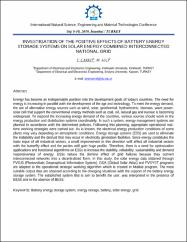| dc.contributor.author | Çarkıt, Taner | |
| dc.contributor.author | Alçı, Mustafa | |
| dc.date | 2019-08-01 | |
| dc.date.accessioned | 2019-08-07T07:59:53Z | |
| dc.date.available | 2019-08-07T07:59:53Z | |
| dc.date.issued | 2019-08-07 | |
| dc.identifier.uri | http://nem2019.klu.edu.tr/EN/index.html | |
| dc.identifier.uri | https://hdl.handle.net/20.500.11857/1080 | |
| dc.description | İlgili çalışma 9-10 Eylül 2019 tarihinde düzenlenecek olan "International Natural Science, Engineering and Material Technologies Conference" etkinliğinde kabul edilmiştir. Konferans tarihi geldiğinde sunum yapılacaktır. | |
| dc.description.abstract | Energy has become an indispensable position into the development goals of today's countries. The need for energy is increasing in parallel with the development of the age and technology. To meet the energy demand; the use of alternative energy sources such as wind, solar, geothermal, hydroelectric, biomass, wave power, solar cell that support the conventional energy methods such as coal, oil, natural gas and nuclear is becoming widespread. To respond the increasing energy demand of the countries, various sources should work in the energy production and distribution systems coordinately. In such a system, energy management systems are planned in accordance with the determined policies. Following this planning, appropriate operational real-time working strategies were carried out. As is known, the electrical energy production conditions of some plants may vary depending on atmospheric conditions. Energy storage systems (ESS) are used to eliminate the instability and the distrust that may occur in electricity generation facilities. Since energy constitutes the basic input of all industrial sectors, a small improvement in this direction will affect all industrial sectors with the butterfly effect and the parties will gain huge profits. Therefore, there is a need for optimization applications and functional algorithms on ESSs to increase the stability, reliability, sustainability and demand responsiveness of energy. ESSs reduce the domino effect of grid failures because they convert interconnected networks into a decentralized form. In this study, the solar energy data obtained through PVGIS (Photovoltaic Geopraphical Information System), GSA (Global Solar Atlas) and PVSYST programs are adapted to the operational strategic working algorithm which is created in Matlab program. The most suitable output data are obtained according to the changing situations with the support of the battery energy storage system. The established system that is aim to benefit the user, was interpreted in the presence of BESS and in the absence of BESS. | |
| dc.language.iso | eng | |
| dc.rights | info:eu-repo/semantics/openAccess | |
| dc.subject | Battery Energy Storage System | |
| dc.subject | Energy Storage | |
| dc.subject | Battery | |
| dc.subject | Solar Energy | |
| dc.subject | Grid | |
| dc.title | Investigation of the Positive Effects of Battery Energy Storage Systems on Solar Energy Combined Interconnected National Grid | |
| dc.type | presentation | |
| dc.department | Fakülteler, Mühendislik Fakültesi, Elektrik-Elektronik Mühendisliği Bölümü | |
| dc.relation.publicationcategory | Diğer | |



















